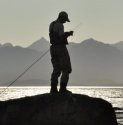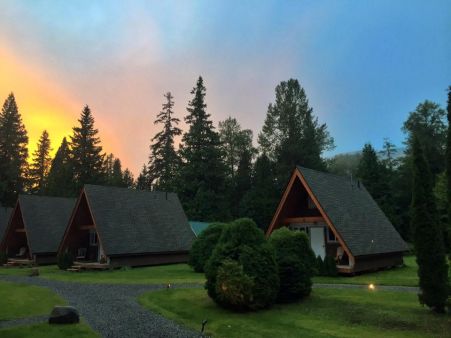Fd: How did you get into fly fishing?
Bob: A friend took me fishing one day on the Bow River in the late 60’s. I caught with a spoon three great rainbows and soon enough fishing became my new passion. At the time, I worked in a department store which had a fishing section. So naturally, I hung out there on my lunch and coffee breaks questioning the department head, who was a fly fisherman from England, about every detail of fish fishing. Our day off from work was a Monday and since he did not have a car I usually offered to use mine to take us to the fishing spots. We formed a great relationship and I learned A LOT from him.
I was fortunate enough to become a member of the Hook and Hackle Club in Calgary. At these club meetings I began to meet many fly fisherman who shared with me there knowledge and experience. In the early days there wasn't really fly tying shops available in regular sporting stores so the club members made a fly tying store on club night. There I began to develop my fly tying and began understanding the materials.
Fd: How did you get involved in guiding?
Bob: In the 70’s I started coming to the Kispiox valley to fish. Before too long, in the late 70’s I moved to the valley and in the early 80’s I started guiding to supplement my income. Guiding was just starting then and getting a license was as easy as requesting one. I was here at the right place at the right time I guess.
Fd: Where did you guide and how long did you guide for?
Bob: I guided for the next ten years and then sold my business, but continued to guide for a further ten years or so for the person I sold my license to. After I sold it, I started setting up a shop and began assembling graphite rods and later making bamboo rods.
Fd: How did you see the river, community and fishing change in those guiding times?
Bob: We have been very lucky in the Kispiox Valley. Unemployment is high and development is low. This combination is good for the environment and for people who want to live a sustainable lifestyle. You have to be a self starter, not someone who needs someone else to give them a job. You make your own and live within your means. The fishing and the experience have held up well.
Fd: What future do you see for the Skeena watershed?
Bob: The Skeena watershed will only continue to prosper if industrial resource development stays away. It’s a constant battle against the people who want to mine the land of it resources to make a quick buck. I remember one of the first feasts I went to in a native village close by. An elder stood up and said not to worship the almighty dollar. What wisdom he spoke!
Fd: How did you get into building bamboo rods?
Bob: My fishing mentors were bamboo guys. When I started fishing it was the fiberglass rod that was king, but the old guys still loved their bamboo. I was greatly influenced by them. So I always had an interest in bamboo and through guiding I met some great builders such as Tom Morgan, who mentored me. The bamboo building community is a sharing one. If you have the desire they will make it happen for you.
Fd: What makes the art of bamboo rod making so special?
Bob: Being able to design and build your own rod is a thing you can do with bamboo. It also is a beautiful material to work with. The combination of beauty, design and function are what draws people to any craft. You are the creator of something that is tangible and real.
Fd: What is your favourite rod you use for fishing your home water and why?
Bob: My favourite rod to fish is an eleven foot 5/6 double handed rod. It’s light and fast and at the end of the day you forget you have a rod in your hand. A lot of people think a 5/6 is too light for steelhead and Atlantic salmon, but you must not forget the 5/6 and think of it as 350 grain rod. That’s a 12 weight in singlehanded terms. Plenty strong enough for any steelhead that swims. Growing up in the American tradition of sportsmanship, a light rod allows you to feel the fish with every turn and shake of its head, and for me this the ultimate feeling.
Fd: Can you talk us through some of the process of producing your bamboo rods?
Bob: Making a bamboo rod seems complicated to the novice. It’s a series of operations. One action leads to the next. It starts with a selection of a culm of bamboo. Splitting, straightening, planning, gluing and finishing. Lots of steps, lots of enjoyment and sometimes a bit of frustration. All part of the game. As I said before, overwhelming at first, but rewarding in the end. A great journey and getting there is the fun of it.
Fd: What makes your fly rods unique?
Bob: Every maker has his influences. His rod is a reflection of his knowledge and skills. When you purchase a rod from a maker you’re getting a piece of him. It’s a bit like an artist’s painting or sculpture. When a person buys one of my rods they're getting the best I can do.
Fd: For me sharing fly fishing moments with my family is very special. How is it for you fly fishing with your family?
Bob: Fishing with my family gives me a very special moment. Every season I have a special moment or two and being with family, fishing, is usually top of the list. Seeing their happiness, their progressing skills and just being there with them is very satisfying.
Fd: Obviously steelhead are without a doubt your favourite species to catch. Is there any other species that you like or would like to catch?
Bob: Steelhead are my favourite but any fish that will take a fly are worth pursuing. Every fish is special. I marvel at how they have adapted to their environment. Artic grayling, wild rainbows, toothy pike, and giant bull trout, all have a special memory for me. Exotic locations usually are beyond my means but dreaming about them is not.
Fd: Do you have any final remarks?
Bob: Fishing to me has been a way of life. People say to me “You are lucky to live where you do, pursue a craft you like, and that you are able to fish A LOT!” But it’s not luck, it’s all been a carefully laid out plan.
To find out more about Bob Clay rods go to: http://www.riverwatchrods.com/about.html































